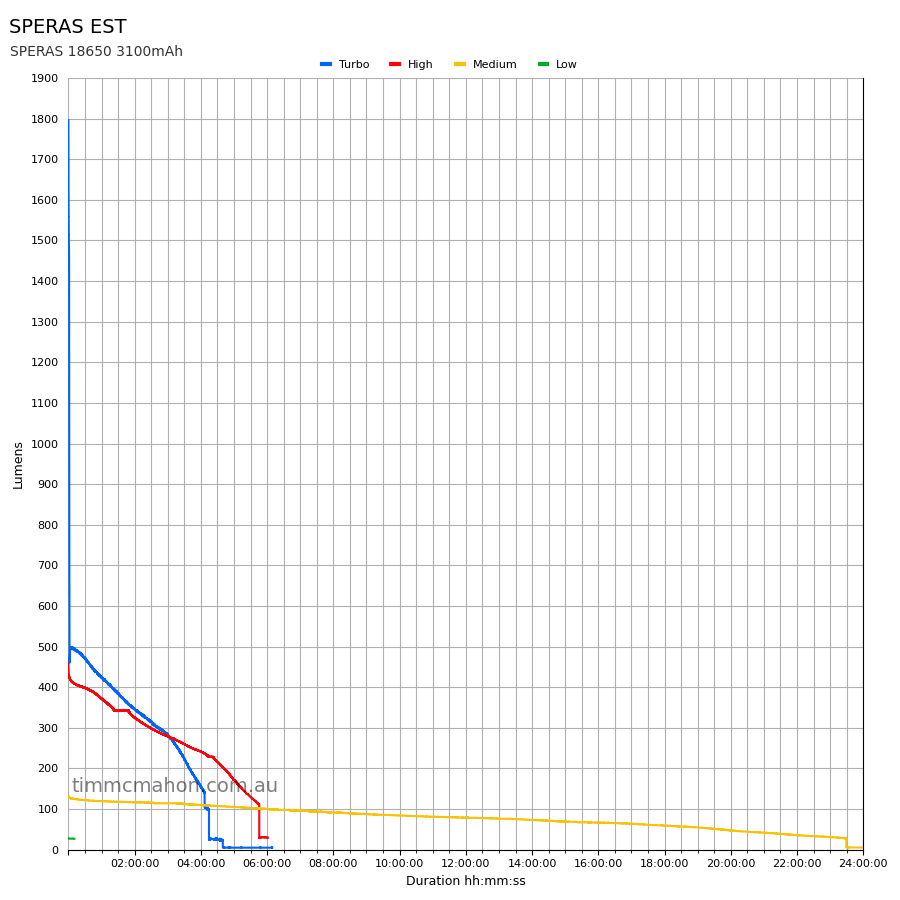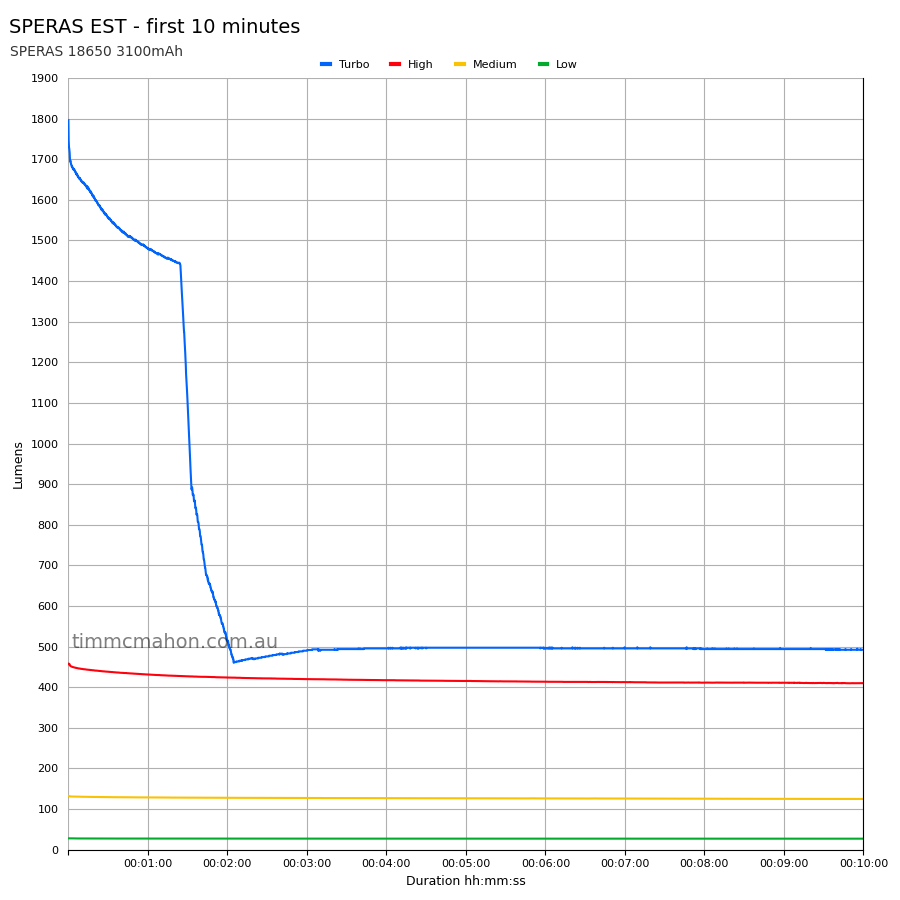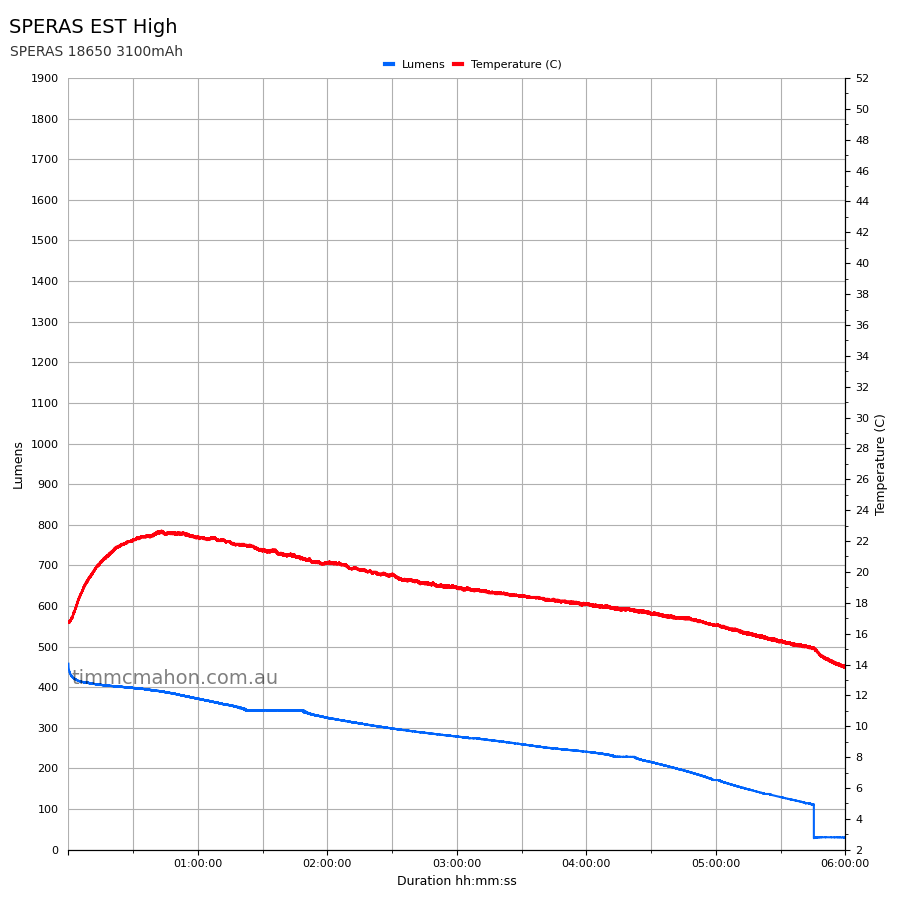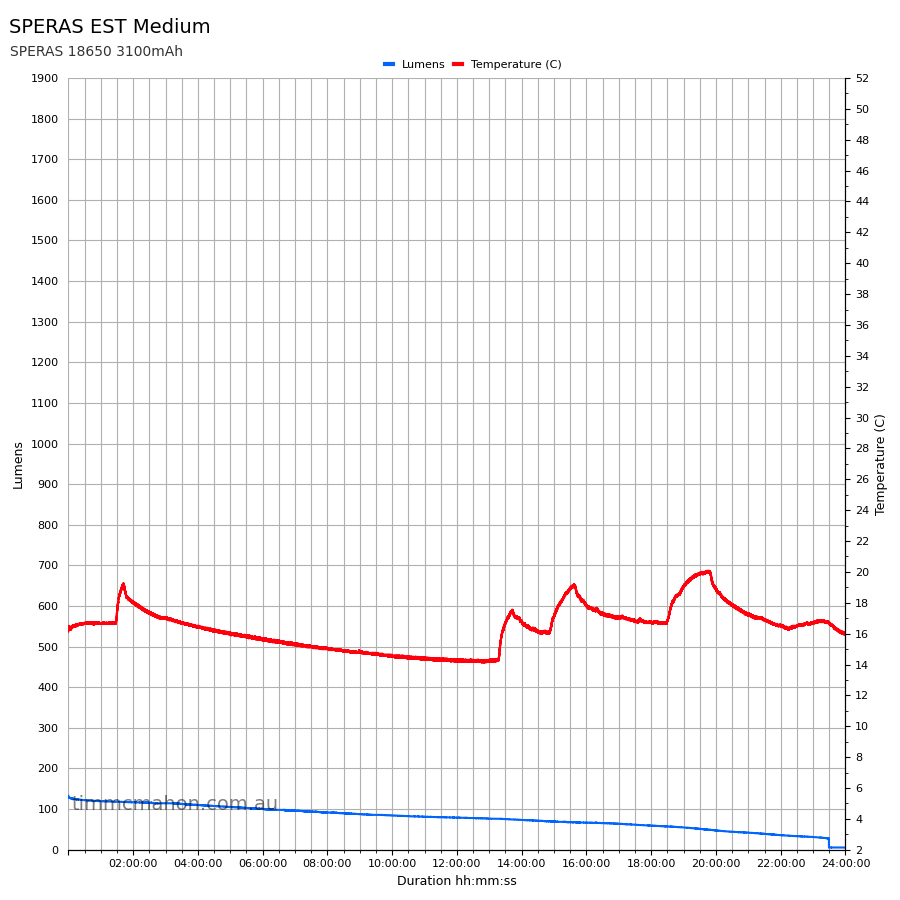SPERAS EST Review
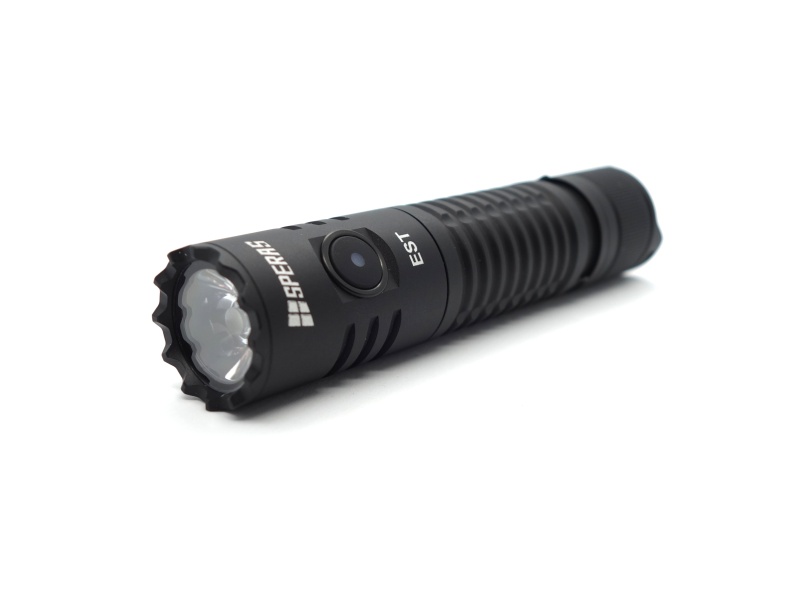
SPERAS EST⌗
- Specifications
- Introduction
- Torch in use
- Build quality
- LED, bezel, lens and beam
- Size and comparison
- User interface and driver
- Batteries and charging
- Performance
- Beamshots
- Conclusion
- Product page
Specifications⌗
| Brand/model | SPERAS EST |
|---|---|
| LED | 1*Luminus SST40 6500K |
| Maximum lumens | 1,900 lm |
| Maximum beam intensity | 11,175 cd |
| Maximum throw | 211 m |
| Battery | 1*18650 Li-ion, 2*CR123A |
| Onboard charging | Yes (USB-C) |
| Material | Aluminium |
| Modes | 4 |
| Blinkies | SOS, Strobe |
| Reflector | TIR |
| Waterproof | IP68 |
| Review date | August 2022 |
Introduction⌗
The SPERAS EST appears to be a dual switch version of the SPERAS E10 with an electronic side switch and a mechanical forward-clicky tail switch. It has a different driver with Low Voltage Protection and it is able to achieve a higher lumen output compared to the E10 on Turbo.
SPERAS provided the EST for review at no cost. Thank you SPERAS! I have not held back my opinions of this torch.
Packaging⌗
The EST came in a white SPERAS branded retail box with a plastic tray.
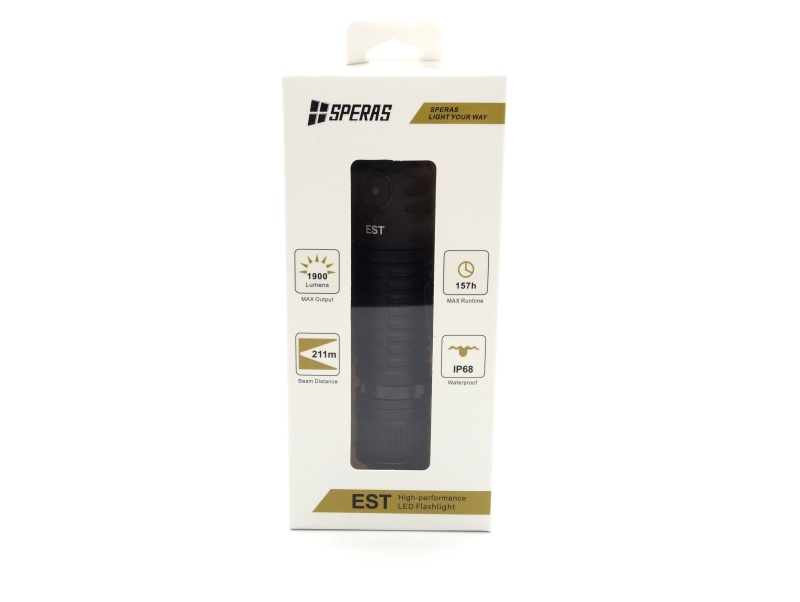

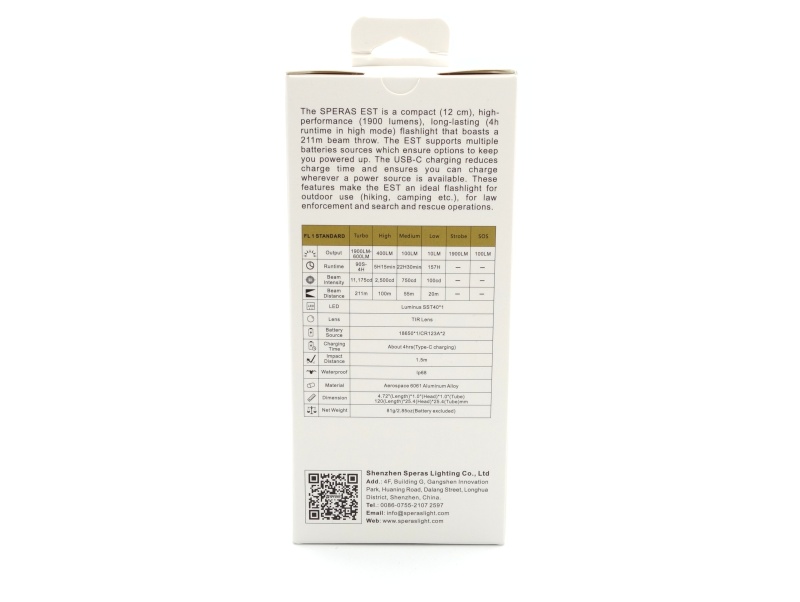
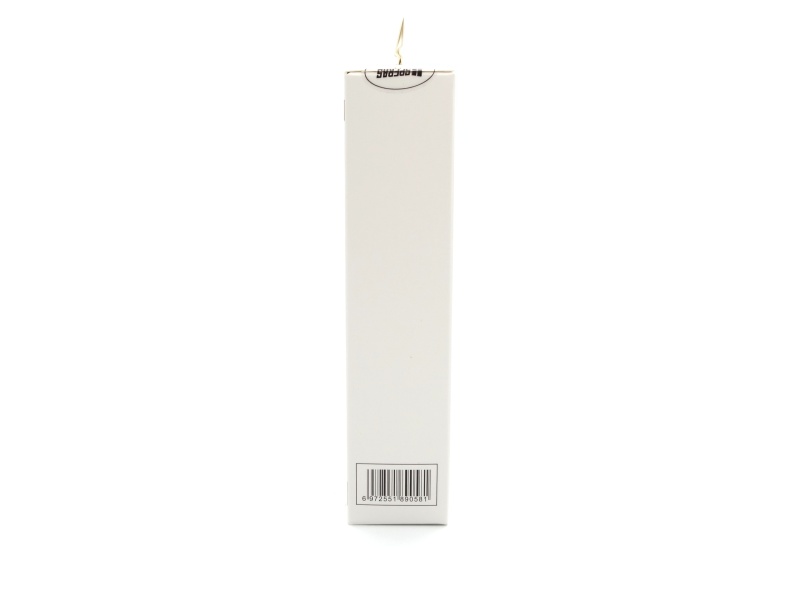
The following was included in the box:
- SPERAS EST
- SPERAS 18650 3100mAh Li-ion cell
- USB-A to USB-C charging cable
- Lanyard
- Two o-rings
- User manual
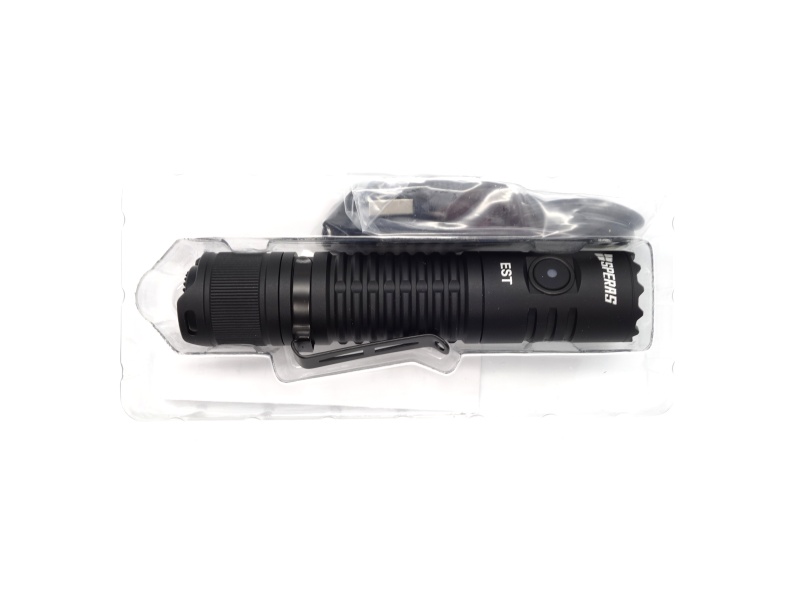
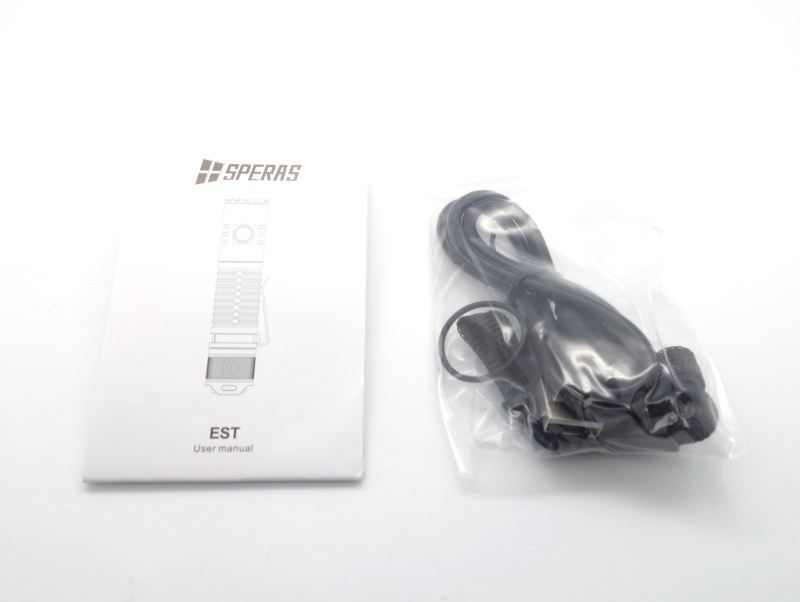
Torch in use⌗
The SPERAS EST has a tactical look and feel due to the matte black finish, tail switch, ribbed tube design and strike bezel.
The pocket clip fits snugly around the tube. It is not a deep carry clip but it can be reversed by reversing the tube.
The charging port cover fits snugly in the head but I sometimes confuse it with the side switch. I have the pocket clip rotated to the right side so that I know where the side switch is when the pocket clip is in the palm of my right hand.
The included lanyard can be attached to one of the holes in the tail cap or to the pocket clip.
The torch can tailstand while the tail switch has been pressed and the light is on. However, the torch falls over while trying to tailstand if the light is off due to the length of the switch boot.


Build quality⌗
The body is made of aluminium. Anodising looks good. There were no scratches on the tube. The inside of the tube has also been anodised.
The fins in the head may be sharp if you squeeze them with your fingers but the rest of the torch is smooth.
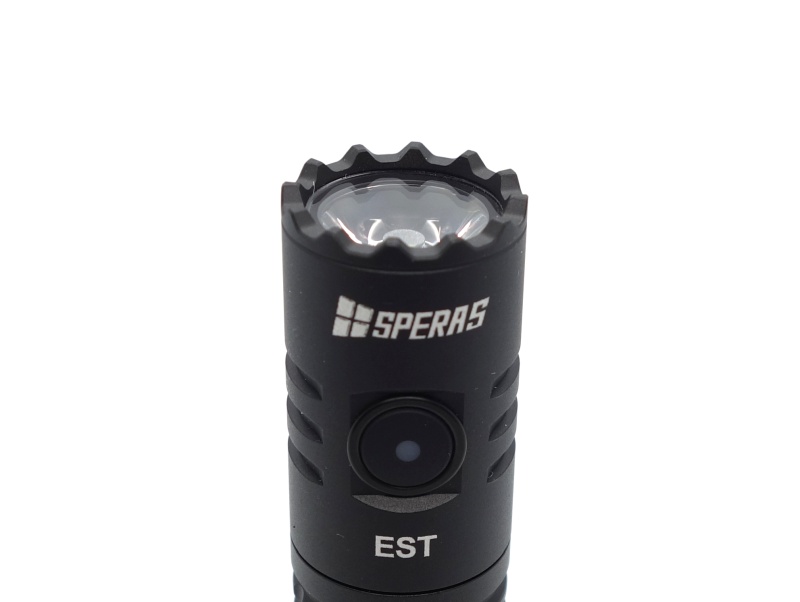
Square cut threads on both ends of the tube came lightly lubricated. The head and tailcap can be easily unscrewed and swapped on the reversible tube. The grip on the tailcap makes it easier to unscrew.
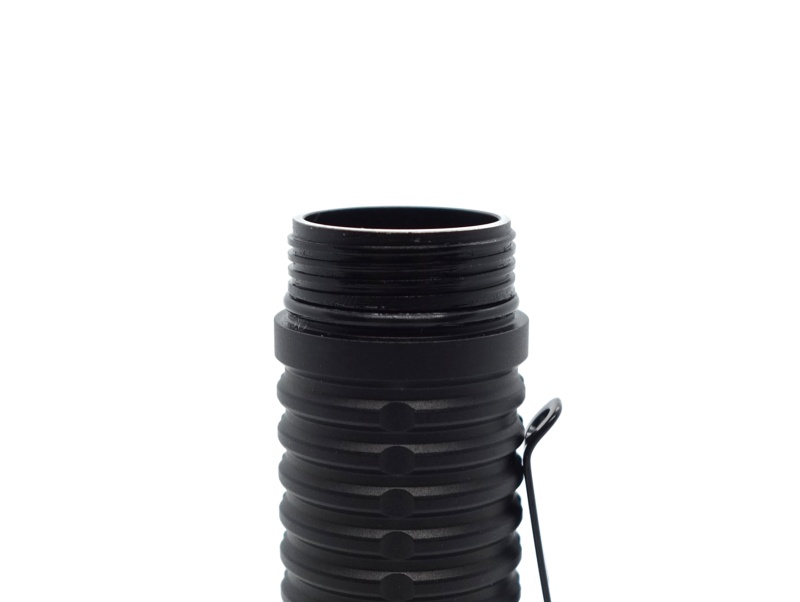
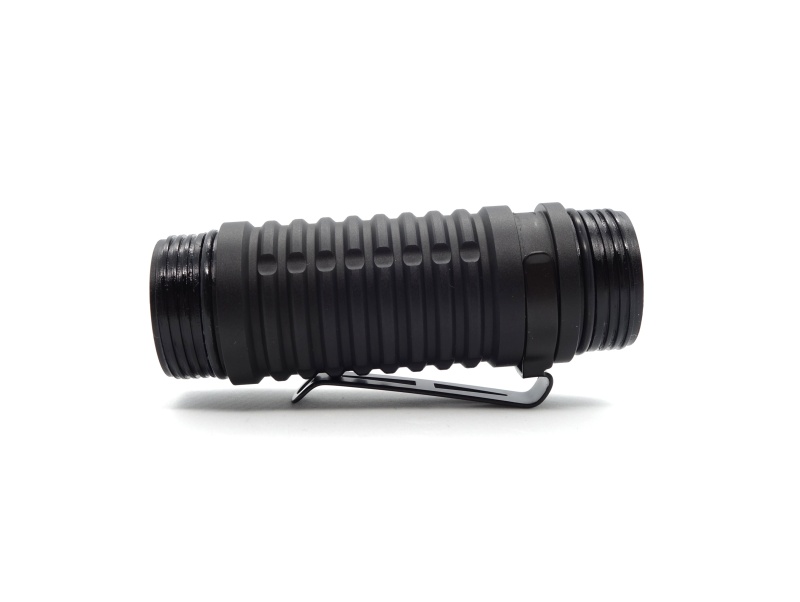
The switch boot is pretty wide in diamater. It does not feel mooshy. It has plenty of grip and activates easily with bit of force.
Springs at the head and tailcap allow flat top or button top 18650 cells or two CR123A cells to fit.
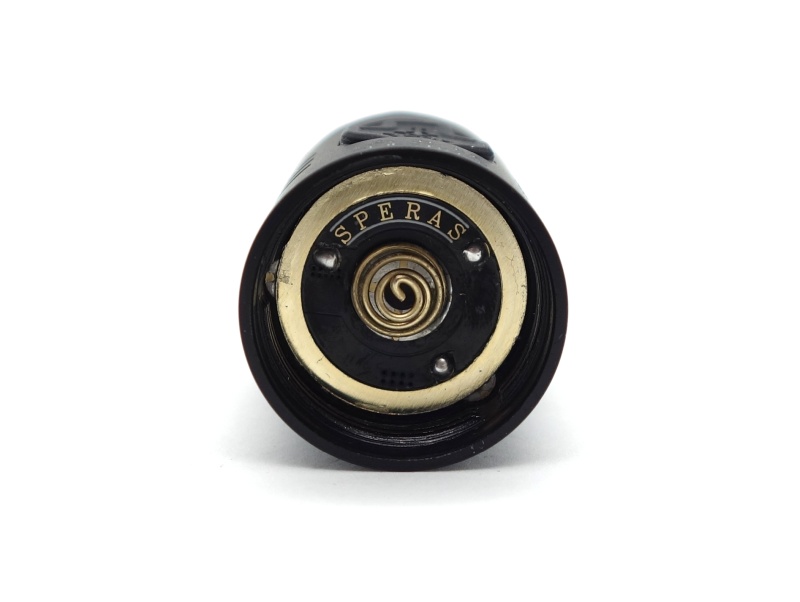

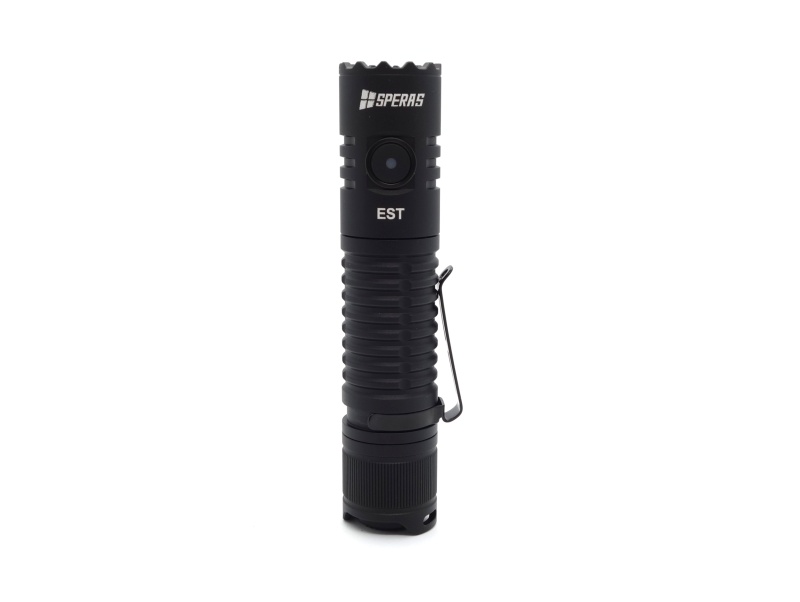
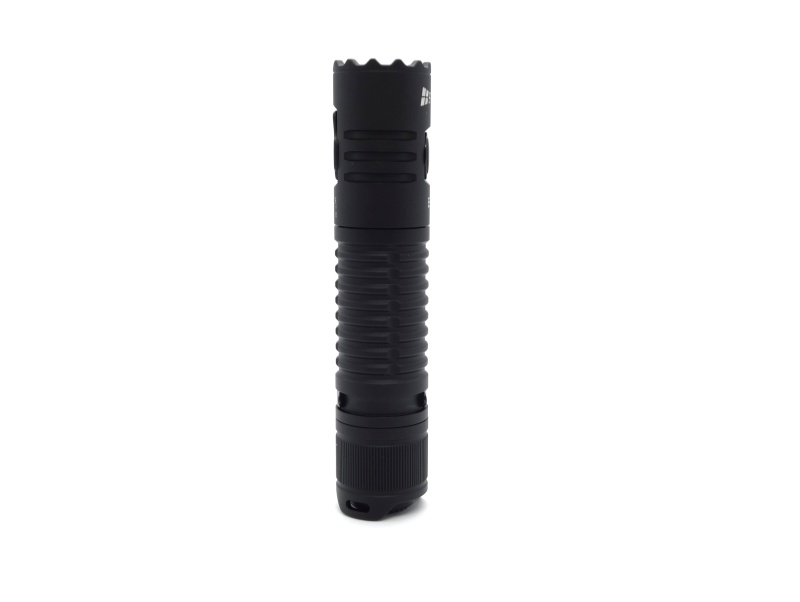
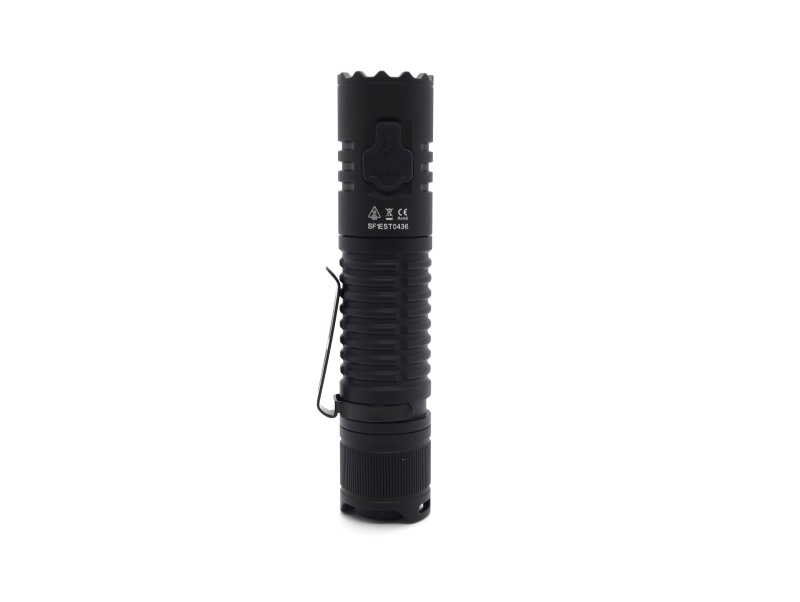
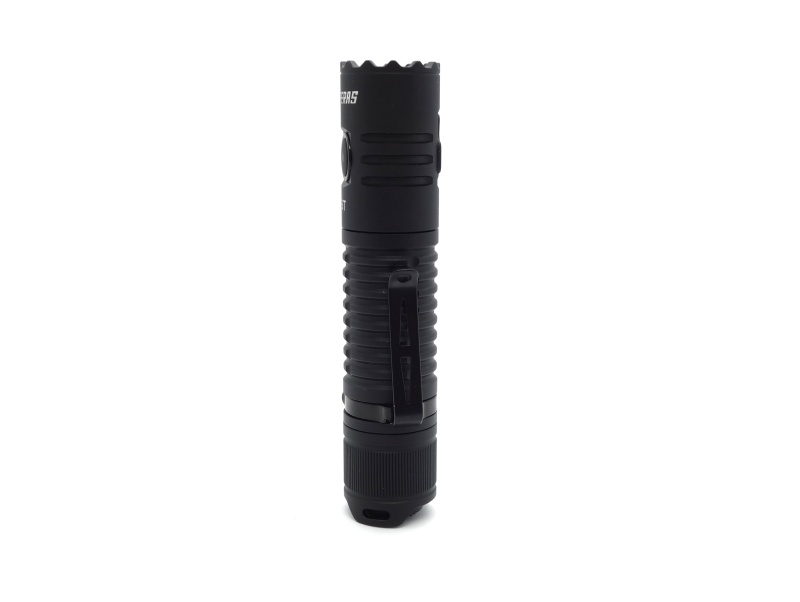
LED, bezel, lens and beam⌗
The EST has a single Luminus SST40 6500K emitter behind a clear TIR optic.
A glass lens appears to be glued to a bezel. The bezel and head appear to be one piece.
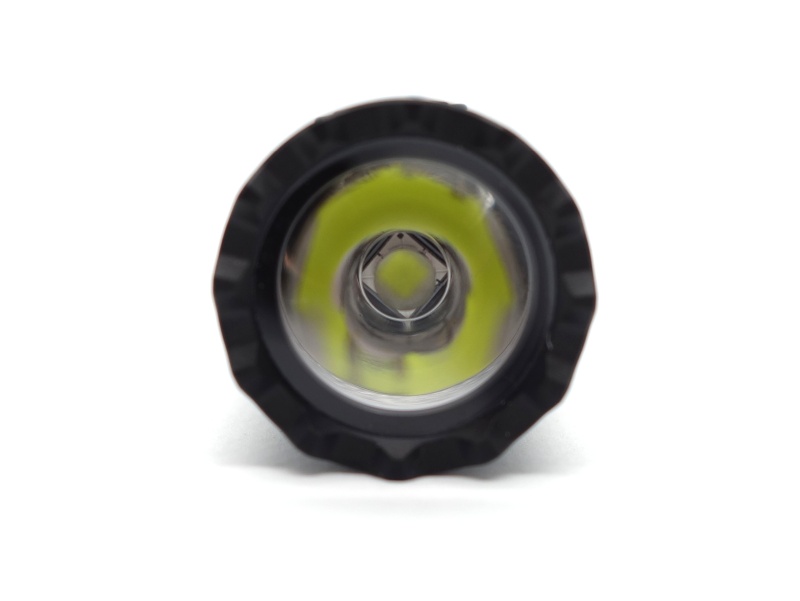
I have taken Correlated Colour Temperature (CCT) and Colour Rendering Index (CRI, RA of R1-R8) measurements with the torch positioned half a metre away from an Opple Light Master Pro III (G3).
The CCT is about 5600K and the CRI is 60+.
The Delta u, v is positive (green).
The beam has a white hot spot with a green corona and a bit of purple around the spill.
| Mode | CCT (K) | CRI (Ra) | x | y | Duv |
|---|---|---|---|---|---|
| Low | 5499 | 60.1 | 0.3326 | 0.3740 | 0.0159 |
| Medium | 5533 | 63.0 | 0.3316 | 0.3676 | 0.0134 |
| High | 5618 | 64.2 | 0.3295 | 0.3612 | 0.0113 |
| Turbo | 5941 | 67.2 | 0.3224 | 0.3460 | 0.0071 |
Calculate Duv from CIE 1931 xy coordinates
Dimensions and size comparison⌗
Dimensions⌗
I took the following measurements using digital callipers.
| Measurement | Unit (mm) |
|---|---|
| Torch length | 120.6 |
| Head diameter | 25.4 |
| Tube diameter | 25.0 |
| Lens diameter | 20.4 |
Weight⌗
I took the following measurements using a digital scale.
| Weight | Unit (g) |
|---|---|
| Torch | 67.3 |
| Battery | 48.8 |
| Pocket clip | 3.1 |
| Torch with battery and clip | 119.2 |
Size comparison with its competition⌗
From left to right: Acebeam E70 Mini, VezerLezer ED10, SPERAS E10, SPERAS EST, Brinyte E18 Pheme

From left to right: Acebeam E70 Mini, VezerLezer ED10, SPERAS E10, SPERAS EST, Brinyte E18 Pheme

User interface and driver⌗
The tail switch is used to turn the torch on and off and it can directly access Strobe. The side switch is used to change the brightness level and enter SOS and Strobe modes.
| State | Action | Result |
|---|---|---|
| Off | Slightly press Tail Switch | Momentary On (mode memory) |
| Off | Click Tail Switch | On (mode memory) |
| Off | Slightly press Tail Switch twice | Momentary Strobe |
| Off | Slighty press and click Tail Switch | Strobe |
| On | Click Side Switch | Cycle (Low, Medium, High, Turbo) |
| On | Double Click Side Switch | Strobe |
| Strobe | Double Click Side Switch | Cycle (SOS, Strobe) |
| SOS | Double Click Side Switch | Cycle (SOS, Strobe) |
Strobe⌗
The strobe frequency alternates between fast and slow blinks.
Battery status⌗
There is a battery capacity indicator on the side of the head of the torch:


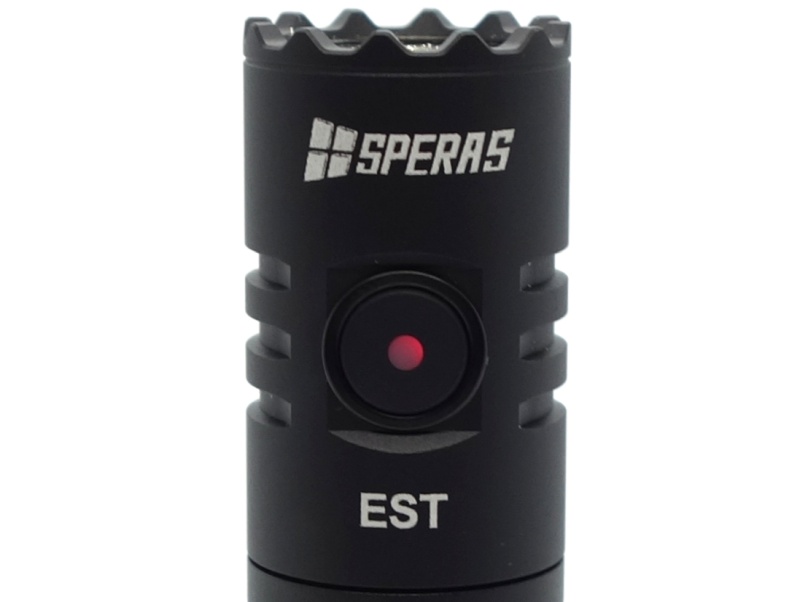
The LED displays the following colour when the torch is on:
| Colour | Battery level |
|---|---|
| Green | Power ≥ 70% |
| Orange | 30% ≤ Power < 70% |
| Red | 10% ≤ Power < 30% |
| Red Flash | Power < 10% |
Low voltage protection⌗
There is LVP. The LED turned off at 2.65V and continued to consume 300uA after that.
PWM⌗
I did not notice any visible PWM (flickering).
What I like about the UI⌗
- Simple and intuitive.
- Direct access to Strobe with the tail switch.
What could be improved⌗
- Direct access to Turbo from off would be nice.
Batteries and charging⌗
Battery⌗
The EST takes a 18650 3.7V Li-ion cell (either button top or flat top) or two CR123A cells.
A button top SPERAS 18650 3100mAh cell was included inside the EST. The cell arrived with a voltage of 3.64V, and it was isolated with a piece of plastic to avoid standby drain.
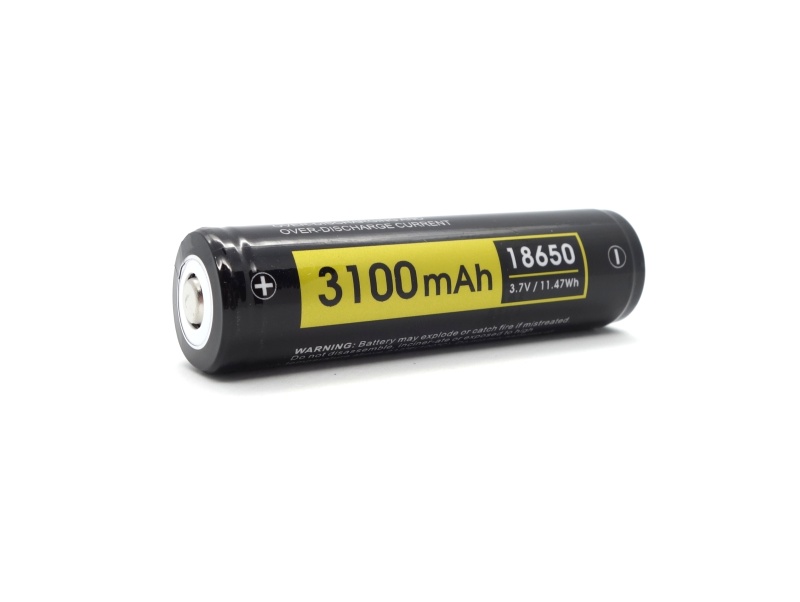
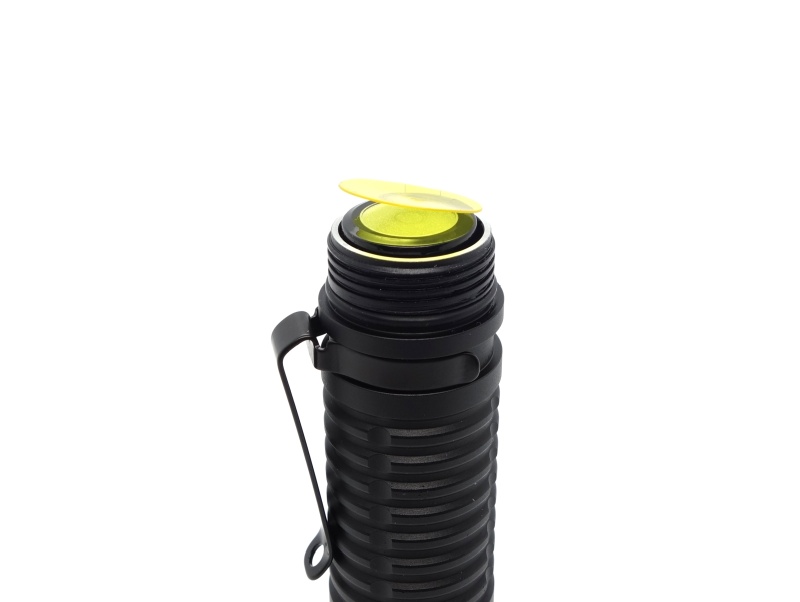
Charging⌗
The SPERAS EST has built-in USB-C charging and came with a USB-A to USB-C cable.
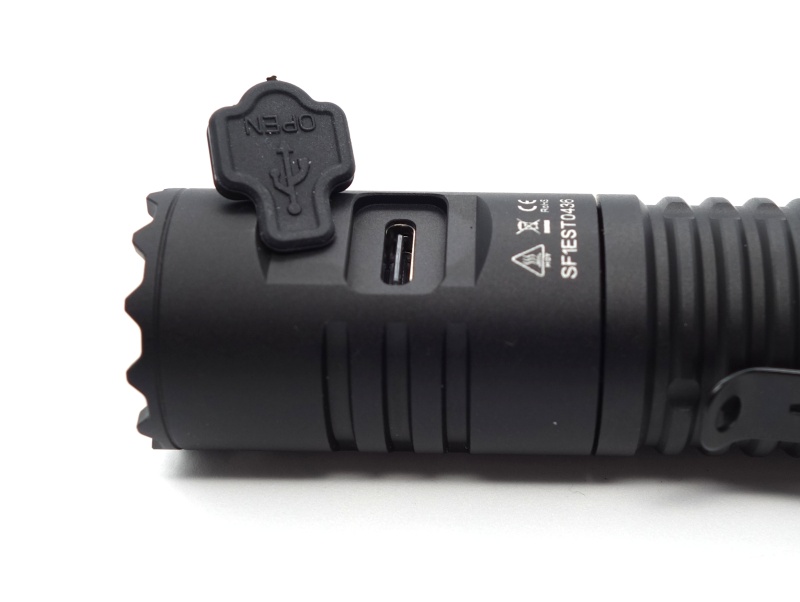
The indicator LED in the side switch is red while a battery is charging and it turns green when the battery is full. The indicator LED is orange when there is no battery or the battery has not been inserted correctly while charging.
Power source: Generic 5V 2.4A Power Supply
Room temperature: 16 C
USB Meter: Ruideng UM25C
I discharged the cell to 2.7V and then charged it in the EST.
The cell charged at 1A for over four hours. The current dropped gradually after the last one and a half hours and charging ended at 4.15V.

Power supply compatibility⌗
I tried the following power supplies with the Speras EST’s built-in USB-C charger:
| Power supply | USB Type | Protocol | Does it charge? |
|---|---|---|---|
| Apple 61W Power Adapter | USB-C | PD | Yes |
| Google Pixel Power Adapter | USB-C | PD | No |
| Generic 5V 2.4A Power Adapter | USB-A | Yes |
USB-C to USB-C works with some power adapters.
USB-A to USB-C works.
Performance⌗
Specifications from the manual:
| FL1 STANDARD | Turbo | High | Medium | Low | Strobe | SOS |
|---|---|---|---|---|---|---|
| Output | 1900lm-600lm | 400lm | 100lm | 10lm | 1900lm | 100lm |
| Runtime | 90s-4h | 5h15min | 22h30min | 157h | - | - |
| Beam Intensity | 11,175cd | 2,500cd | 750cd | 100cd | - | - |
| Beam Distance | 211m | 100m | 55m | - | - |
Lumen measurements⌗
| Mode | Amps at start | Specs | Lumens @turn on | Lumens @30 sec | Lumens @10 min |
|---|---|---|---|---|---|
| Low | 0.04 A | 10 lm | 28 lm | 27 lm | 27 lm |
| Medium | 0.18 A | 100 lm | 132 lm | 129 lm | 124 lm |
| High | 0.78 A | 400 lm | 458 lm | 437 lm | 409 lm |
| Turbo | 4.98 A | 1900 lm | 1796 lm | 1556 lm | 492 lm |
Standby drain⌗
No standby drain. This torch has a mechanical tail switch.
Runtime graphs⌗
I built a lumen tube and forked bmengineer’s project RuTiTe to add support for a VEML7700 light sensor and MCP9808 temperature sensor with help from Owen. Calibration lights from maukka were used. I changed the sensor to a TSL2591 to improve the accuracy above 800 lumens and tested Turbo with it.
Note: Lumen measurements may be off by 10% with my DIY lumen tube.
Temperature may vary due to the room temperature and it may be lower than expected due to how I attached the sensor. Measurements were taken in my office where the ambient temperature may fluctuate between 6C and 21C during winter.
It is nice how SPERAS distinguished between Turbo starting at 1900 lumens and stepping down to 600 lumens after 90 seconds in the user manual. This transparency and honesty is appreciated and helps set expectations.
Turbo started at 1796 lumens and stepped down to 1002 lumens after 90 seconds. It dropped to 470 lumens after 30 minutes and continued to drop around 150 lumens at 4 hours. The EST kept going beyond 4 hours with a very low light output.
High started at 458 lumens and gradually stepped down over 5 hours. The EST kept going beyond 5 hours with a very low light output.
Medium started at 132 lumens and gradually stepped down over 22 hours 45 minutes. The EST kept going beyond 22 hours 45 minutes with a very low light output.
I stopped runtime testing of Turbo and High at 6 hours, Medium at 24 hours, and Low at 10 minutes.
My runtime results were similar to SPERAS results. It would be nice if light output could be consistent for hours instead of gradually dropping as the battery voltage decreases.
Throw⌗
I took lux measurements with a UT383BT after 30 seconds for each mode. Each mode was measured at five metres.
The included 18650 cell was used. I charged it up to 4.20 V before measuring each mode.
| Mode | Specs (cd) | Specs (m) | Candela measured (cd) | Distance (m) |
|---|---|---|---|---|
| Low | 100 | 20 | 75 | 17 |
| Medium | 750 | 55 | 800 | 56 |
| High | 2,500 | 100 | 3,350 | 115 |
| Turbo | 11,175 | 211 | 13,250 | 230 |
Beamshots⌗
I went to a local park and aimed the SPERAS EST at a tree 70 metres away while using Turbo.
Beamshots were taken using a Sony RX100M2 using 3.2", f3.2, ISO 100, 5000K WB.
SPERAS EST⌗
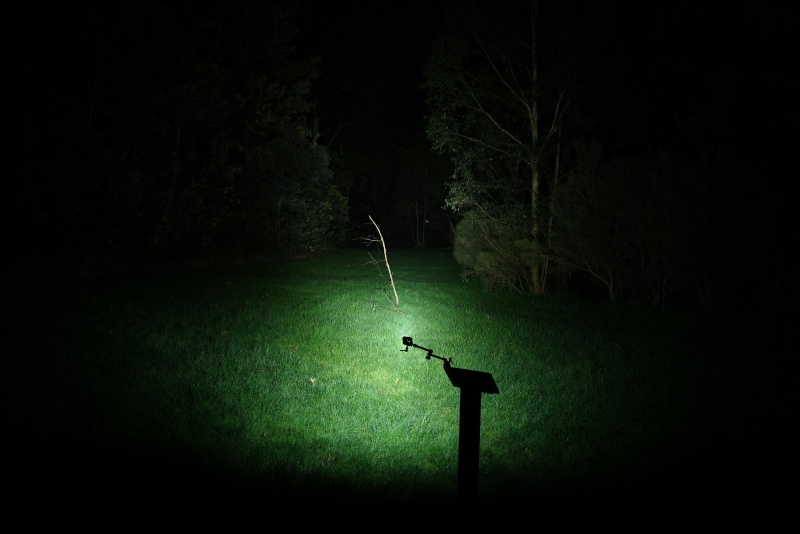
SPERAS E10⌗

Brinyte E18 Pheme⌗

Olight Warrior Mini 2⌗

Conclusion⌗
The SPERAS EST is a well built EDC torch with a tactical look and feel.
The Luminus SST40 LED is good at producing a beam that throws far but it has a low CRI and looks slightly green on low levels. It would be nice if a LED with a high CRI, neutral duv (pure white), and a warmer colour temperature is used.
A well regulated driver to produce a consistent light output would be nice. Light output decreases as the battery voltage decreases.
Would I recommend the SPERAS EST? Yes, the build quality is great.
Pros:⌗
- All-in-one kit (torch, battery, built-in charger)
- Great build quality
- Good runtime
- Simple user interface
Cons:⌗
- Low CRI
- Driver regulation

